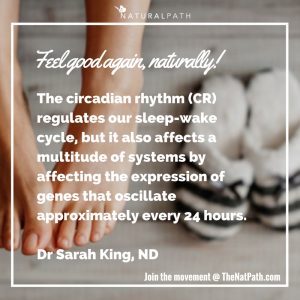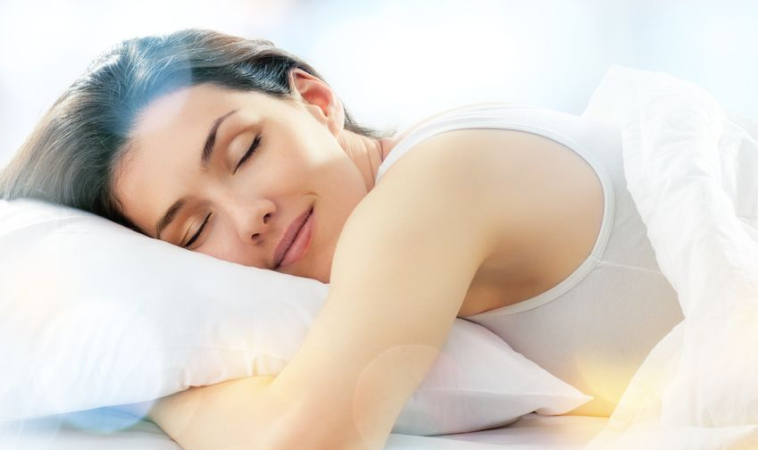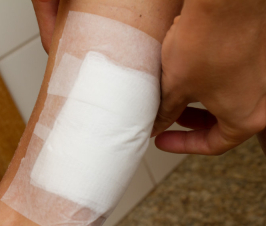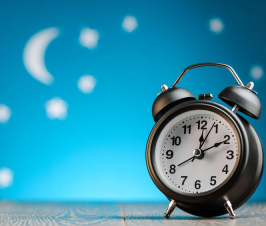The Sun, Electric Lighting, and Sleep Schedules
 For many thousands of years, the sun was the only source of light for humans, and as such, our behaviour followed a natural day-night or light-dark cycle.1,2 With the invention of electric lighting about 150 years ago, our sleep-wake cycles were altered and since then we’ve had much more flexibility with our working and social hours.1
For many thousands of years, the sun was the only source of light for humans, and as such, our behaviour followed a natural day-night or light-dark cycle.1,2 With the invention of electric lighting about 150 years ago, our sleep-wake cycles were altered and since then we’ve had much more flexibility with our working and social hours.1
Circadian Rhythm (CR) Regulates Sleep-Wake Cycle and More
The circadian rhythm (CR) regulates our sleep-wake cycle, but it also affects a multitude of systems by affecting the expression of genes that oscillate approximately every 24 hours. The up-regulation and expression of these specific genes induces many regulatory systems, including the immune system, the endocrine system, and the neurologic system.1,3
Sleep-Wake Phases
The timing and intensity of our light exposure are just two factors in setting our CR. Sleep-wake phases are also affected by: genetic polymorphisms (mutations or deletions in CR genes),4 exogenous melatonin supplementation,5 as well as excessive alcohol consumption, caffeine, nicotine, and unhealthy dietary habits.5 However, in general, the timing of light exposure has been shown to be most critical in shifting circadian timing.5
It is estimated that 15-30% of the workforce in North America operates outside of standard daytime hours.6,7 This can lead to many CR sleep disorders including Shift Work Disorder, Jet Lag Disorder, or Sleep Phase Disorders.8 The consequences of sleep deprivation from these conditions range from fatigue and decreased daytime concentration, to an increased risk of cardiovascular disease, and breast cancer.2,6
For those who experience a social jet lag, naturally falling asleep later and waking later, new research shows that for some “night owls” their delayed clock may be caused by a genetic polymorphism in circadian clock genes.4
Effect of Timing, Intensity, and Wavelength of Light on the CR
The hormone melatonin is an important driver of the circadian clock. Endogenous melatonin levels typically start to rise in dim light about 2-3 hours before our habitual bedtime, but can be suppressed with our exposure to light.5 Evening light exposure has been shown to delay circadian timing,5 even more so depending on the wavelength of light. For example, melatonin release is suppressed by specific wavelengths of blue light in the 450-480nm range.9,10 LED displays and electronic devices such as cell phones and computer screens tend to emit light in this range, and therefore can be used to promote alertness and wakefulness. But due to this effect, these light sources are best avoided when trying to preserve habitual sleep times, and promote sleepiness in the late evening.9,10
One study of shift-working nurses showed that nighttime exposure to bright light improved alertness and performance during their night-shifts.11 To further support shift workers, exposure to morning bright light has been shown to improve adaptation to day life by correcting the sleep-wake cycle.11 This study demonstrated that as little as 8-10 minutes of bright light exposure in the morning before working a day shift significantly improved sleepiness and fatigue at 10:00am.11
Even for those who are not shift workers, bright light exposure in the morning, before and after habitual wake time can advance circadian timing, promoting an earlier bedtime, while reducing daytime fatigue.5
Genetic Factors leading to “Night Owl” Behaviour
On average, we have developed a 24-hour circadian period, which coincides with the rotation of the earth, however, not all individuals run on this 24-hour clock. In fact, some may experience a circadian period around a 25- to 26-hour range, meaning that upon typical wake time, these “night owls” aren’t ready to start their day, hence the need to sleep in later.4
Interestingly, new research has shown that changes in scheduling, and light exposure, may not be the only causes of these phase-related sleep disorders.4 Specifically, variations in the circadian clock gene CRY1 can cause a lengthening of the circadian period.4 About 0.2-10% of the population experiences a delayed sleep phase disorder, however, not all cases are due to these genetic polymorphisms.4 Regardless, this may open up new avenues for research and development into the treatment of genetically-linked delayed sleep phase disorders.
Health Effects from Unregulated CR
In addition to regulating the sleep-wake cycle, circadian clock genes have many other regulatory functions. In fact, the proteins produced from CR gene expression have been closely linked to the cardiovascular system. It has been documented and confirmed in over 60,000 cases that there is a 3-fold higher incidence of experiencing a myocardial infarction (heart attack) in the morning, as compared to the late evening hours.1
Other patterns have been found linking CRs with unstable angina, stroke, ventricular arrhythmias, and other cardiovascular events.1 Although the pathophysiology is not completely understood, it is likely that circadian-regulated proteins and hormones contribute to plaque rupture, and modulate the response of myocardial tissue to ischemia.1
To further our understanding, animal studies have shown that daylight exposure increases the circadian protein Per2 in the heart, resulting in cardio-protection from ischemia.1 Therefore, the timing of proper light exposure in a day-night cycle may be a factor in protecting the heart from cardiovascular events.
This also coincides with the health risks associated with improper timing of light, especially at night. Chronic nighttime exposure to light has been linked to multiple health risks including elevated blood triglycerides, poor cholesterol balance, and increased body mass and waist circumference.1 Additionally, CR disruptions can cause premature aging, diabetes, hypertension, and immune deficiencies.1
What’s more alarming is that some of these effects may be passed from parent to offspring. A 2017 study in hamsters showed that when parents are subjected to irregular light exposure (and therefore display an irregular CR) before mating, their pups are born with weakened immune systems and decreased expressed of melatonin and glucocorticoid receptions in the spleen.12 This is the first study to show that nighttime light exposure may lead to immune and endocrine system dysfunction in offspring.12
We know that naturally-cycling light exposure can be used to re-synchronize CRs, therefore this may present a treatment option for circadian-related illnesses via natural daylight, or high intensity light machines.1 Several hospitals in the United Kingdom, German, Sweden and the Netherlands are already investigating the use of daylight therapy to simulate proper day and night environments.1
Shifting and Correcting Dysfunctional CRs
Optimal immune and endocrine function depends on an intact CR.12 In understanding the critical role that a regulated CR plays in our health, it’s important that we become aware of the timing of our daily light exposure. For some, we can use light exposure timing to delay or advance the circadian clock based on individual needs.7
Morning and daytime bright light exposure has many benefits, including increasing alertness, decreasing fatigue,10,11 and may increase melatonin secretion at night.2 Morning light exposure tends to be beneficial for most people as it provides a corrective phase advance to overcome the natural tendency to shift sleep later.5
Complementing this is the avoidance of nighttime light, which suppresses melatonin. There are increasing concerns with our screen use before bed, therefore it is advised to limit the use of large screens at night, and/or switching to “night mode” on your devices (if available) to eliminate exposure to blue wavelengths of light.2 This is especially important in those with delayed-phase disorders and those with an endogenous circadian period of more than 24 hours.5
For those who spend much of the morning and daytime in underground or dimly lit environments, it may be helpful (or necessary) to reorganize scheduling to allow for outdoor morning activities, or to use a light box in the workspace.5 Shift workers, conversely, may find it helpful to wear dark sunglasses during their morning commute home to reduce the effects of phase-advancing from morning light.5
Most importantly, consistency is crucial. Implementing a routine or setting a reminder alarm may be helpful to promote consistent timing of light exposure for optimal circadian function.
References:
- Brainard, J., Gobel, M., Scott, B., Koeppen, M, and Eckle, T. “Health implications of disrupted circadian rhythms and the potential for daylight as therapy” Anesthesiology. 2015; 122(5): 1170-5
- Kozaki, T., Kubokawa, A., Taketomi, R., and Hatae, K. “Effects of day-time exposure to different light intensities on light-induced melatonin suppression at night” J Physiol Anthropol.2015; 34: 27
- Zeitzer, J.M., Fisicaro, R.A., Ruby, N.F., and Heller, H.C. “Millisecond flashes of light phase delay the human circadian clock during sleep” J Biol Rhythms. 2014; 29(5): 370-6
- Patki, A., Murphy, P.J., Onat, O.E., et al. “Mutation of the human circadian clock gene CRY1 in familial delayed sleep phase disorder” Cell. 2017; 169(2); 203-215.e13
- Emens, J.S, and Burgess, H.J. “Effect of light and melatonin and other melatonin receptor agonists on human circadian physiology” Sleep Med Clin. 2015; 10(4): 435-53
- Kavcic, P., Rojc, B., Dolenc-Groseli, L., et al. “The impact of sleep deprivation and nighttime light exposure on clock gene expression in humans” Croat Med J. 2011; 52(5): 594-60
- Serkh, K., and Forger, D.B. “Optimal schedules of light exposure for rapidly correcting circadian misalignment” PLoS Comput Biol.2014; 10(4): e1003523
- Dewan, K., Benloucif, S., Reid, K., Wolfe, L.F., and Zee, P.C. “Light-induced changes of the circadian clock of humans: increasing duration is more effective than increasing light intensity” Sleep. 2011; 34(5): 593-9
- Hersh, C., Sisti, J., Richiutti, V., and Schemhammer, E. “The effects of sleep and light at night on melatonin in adolescents” Hormones (Athens). 2015; 14(3): 399-409
- Rahman, S.A., Flynn-Evens, E.E., Aeschbach, D., et al. “Diurnal spectral sensitivity of the acute alerting effects of light” Sleep. 2014; 37(2): 271-81
- Tanaka, K., Takahashi, M., Tanaka, M., et al. “Brief morning exposure to bright light improves subjective symptoms and performance in nurses with rapidly rotating shifts” J Occup Health. 2011; 53(4): 258-66
- Cissé, Y.M., Russet, K.L.G., and Nelson, R.J. “Parental exposure to dim light at night prior to mating alters offspring adaptive immunity” Sci Rep. 2017; 7:45497
 Dr. Sarah King is a licensed Naturopathic Doctor, graduating from the Canadian College of Naturopathic Medicine in 2014. Prior to completing her medical studies, she attended Nipissing University where she received her Honors Bachelor of Science in Biology. Sarah has a passion for women’s health and is a birth doula in Durham and Toronto Region. She treats a wide variety of health conditions including menstrual disorders and hormone balancing, fertility, prenatal care, digestive concerns, skincare and mental health/anxiety. Outside the office Sarah is an avid runner with a love of the GTA’s best forest trails. She also continues to improve her yoga practice and teaches breath work as part of stress management counselling to her patients.
Dr. Sarah King is a licensed Naturopathic Doctor, graduating from the Canadian College of Naturopathic Medicine in 2014. Prior to completing her medical studies, she attended Nipissing University where she received her Honors Bachelor of Science in Biology. Sarah has a passion for women’s health and is a birth doula in Durham and Toronto Region. She treats a wide variety of health conditions including menstrual disorders and hormone balancing, fertility, prenatal care, digestive concerns, skincare and mental health/anxiety. Outside the office Sarah is an avid runner with a love of the GTA’s best forest trails. She also continues to improve her yoga practice and teaches breath work as part of stress management counselling to her patients.


















Hello Sarah, this is a very nice overview about the effects of timed exposure of light on CR. For this matter we developed the App driven Propeaq lightglasses. Propeaq is used by many elite athletes and among them 115 Olympians on their way to Rio2016. They use the device for beating jetlag and to perform at their best during early morning or late evening matches, depending on their personal peak performance moment. Please feel free to visit http://www.propeaq.com/en for more info. regards, Toine